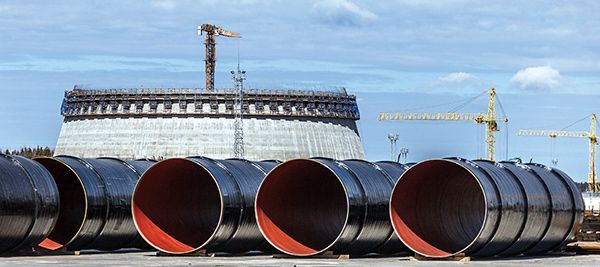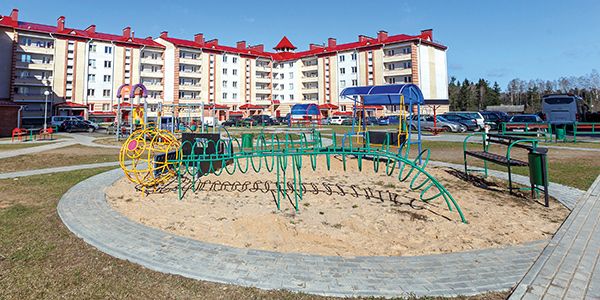
At the construction of Belarusian nuclear power station objects
Construction of residential district #1 is close to completion, along one side of a newly asphalted road, leading to the station. Thirteen multi-storey buildings are already open and the state commission is soon to sign off upon another two. The second residential district is being built on the opposite side, with three buildings ready and another five to come. The district will reach full completion by 2016 and, a year later, construction of a third will be launched, where the current centre of the original town exists.
In addition, a school and kindergartens are being built, as the Chairman of Ostrovets District Executive Committee, Adam Kovalko, proudly explains. He tells us, “We’ll provide comfortable accommodation to all those building the station. As regards future staff, many have already arrived with their families so we’ll soon launch construction of a new kindergarten. We need to develop communal housing, while expanding heating and sewerage infrastructure. We’ll soon begin on a new block for the local hospital, supplying 400 beds and the latest equipment, at a cost of over Br1 trillion.”
According to forecasts, after the second reactor comes into operation, Ostrovets’ population will grow to 25,000: triple its original size. The Belarusian-Russian construction site will see the biggest physical changes this year, including the raising of a 167m cooling tower (rivalling the tallest Minsk buildings) — for cooling the nuclear power station’s aggregates.
The construction site is the most important in Belarus, with 102 major objects, the tallest so far being 34m high. The first reactor will be over 44m tall (above sea level). This year, more than $650 mln is being spent on construction at the site, with around 50,000 tonnes of fittings assembled (transported by a thousand railway carriages) and 360,000 cubic metres of concrete spread. The trucks necessary to deliver so many construction materials would connect Minsk and Moscow! The scale of the thick reactor casing is also difficult to comprehend; it requires several dozen cranes.
This year, 6,200 specialists will be working on the site (up from 3,500). Most will be from Belarus, with some Russians (workers with the general contracting company and those assembling necessary equipment and devices). Most of the equipment has been imported from Russia and is now on site. The power station’s general director, Mikhail Filimonov, notes, “I must praise our joint work. The plans we outlined at the beginning of construction have been realised. We have one language and practically the same culture. We also boast one and the same education, having studied from the same textbooks. Moreover, Russia boasts highly qualified specialists, such as Vladimir Masalsky, who was born not far from here and who helped construct Minsk’s nuclear heat and power station [reduced merely to a heating power station after the Chernobyl catastrophe]. He now represents a large Russian assembly organisation involved in constructing the nuclear building, so we are liaising closely. Our best joint experience is being brought to bear but at a higher level; accordingly, we’re proceeding to schedule.”
The high pace of construction is assisted by technological approaches, such as large-block assembly of the reactor. Thick segments of steel corrugated fittings are pre-welded, ready for assembly on site by cranes. Their anti-corrosion covering will prevent against rust for years to come. Meanwhile, huge steel pipes to circulate the cooling water supply are being welded in Belarus (saving the cost of importing from Ukraine and Russia).
Of course, we could leave everything to the general contractor, including the employment of its own workers, but it saves a great deal of money to work locally. Today’s expenses will influence the prime cost of the electricity first produced by the Belarusian nuclear power station, launching in 2018 (for 60 years). Naturally, costs must be recouped.
Many neighbouring states are keen to purchase Belarusian electricity, comments Energy Minister Vladimir Potupchik. He emphasises, “Our major task is to be competitive on the domestic market, as well as on the Eurasian market; our costs must rival the best worldwide, which means spending wisely on construction. According to our calculations, the participation of Belarusian organisations has saved us around $2 bln.”

Chairman of Ostrovets District Executive Committee, Adam Kovalko, proudly explains:
We’ll provide comfortable accommodation to all those building the station. As regards future staff, many have already arrived with their families so we’ll soon launch construction of a new kindergarten. We need to develop communal housing, while expanding heating and sewerage infrastructure. We’ll soon begin on a new block for the local hospital, supplying 400 beds and the latest equipment, at a cost of over Br1 trillion

This year, more than $650 mln is being spent on construction at the site, with around 50,000 tonnes of fittings assembled (transported by a thousand railway carriages) and 360,000 cubic metres of concrete spread. The trucks necessary to deliver so many construction materials would connect Minsk and Moscow
By Vladimir Yakovlev
Photo: Alexander Ruzhechka











